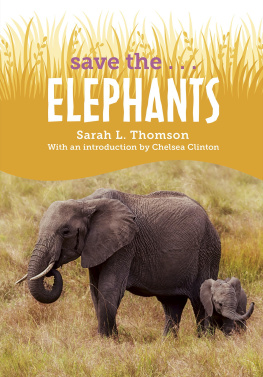To Lorenzo Buttignol
Special thanks to Jim Doherty,
General Curator Emeritus of the New York Zoological Society,
Bronx, New York.
Copyright 2008 by Gail Gibbons
All Rghts Reserved
HOLIDAY HOUSE is registered in the U.S.
Patent and Trademark Office
Printed and bound in June 2011 at
Worzalla, Stevens Point, WI, USA.
www.holidayhouse.com
3 5 7 9 10 8 6 4
Library of Congress Cataloging-in-Publication Data
Gibbons, Gail.
Elephants of Africa / by Gail Gibbons. 1st ed.
p. cm.
ISBN 978-0-8234-2168-8 (hardcover)
ISBN 978-0-8234-2299-9 (paperback)
1. ElephantsJuvenile literature. I. Title.
QL737.P98G53 2008
599.67dc22
A herd of African elephants makes its way across the vast savanna. Elephants are the largest living land animals.
A SAVANNA is a
large grassland
with scattered trees.
A HERD is a group of the
same kind of animals.
African elephants also live in forests.
AREAS IN AFRICA
WHERE MOST
ELEPHANTS LIVE
AFRICA
ATLANTIC
OCEAN
INDIAN
OCEAN
Thousands of years ago there were about different kinds of elephants. The mammoth and the mastodon were prehistoric members of the elephant family. They had thick fur to protect them from the cold.
MAMMOTH
MASTODON
A male African elephant can grow to be feet (3.9 meters) tall and weigh as much as tons (6.3 metric tons). Females are smaller and weigh about tons (4.5 metric tons).
AFRICAN ELEPHANT CHARACTERISTICS
ARCHED
BACK
LARGE EARS
FLAT
FOREHEAD
EYE
TRUNK
NECK
MOUTH
TUSKS
Two FINGERS
at end of trunk
THICK LEGS
PADDED FEET
TOENAILS
TAIL with thick
hair at end
The trunk of an elephant is a combination of its nose and its
upper lip. It is strong and flexible, and has many uses.
AN ELEPHANTS TRUNK
The trunk has
thousands of
muscles. The
fingers at the
end of the trunk
are so sensitive
that they can pick
a leaf off a tree.
BREATHING
SMELLING
DRINKING
COMMUNICATING
EATING
REACHING AND PULLING
DIGGING
SHOWERING
SNORKELING
Tusks are large teeth that grow out of each side of the upper jaw. An elephant uses its tusks in many different ways.
AN ELEPHANTS TUSKS
TUSKS
STRIPPING OFF
BARK FOR FOOD
DIGGING FOR
WATER
DIGGING UP ROOTS FOR FOOD
DEFENDING
THEIR YOUNG
MALES BATTLING OVER
A POSSIBLE MATE
Tusks start to grow when an elephant is very young and continue to grow throughout its life. They can be as long as feet (3.9 meters) and weigh as much as pounds (90.7 kilograms).
Most of the skin of an elephant is about 1.5 inches (3.8 centimeters) thick to protect the elephant from its harsh environment. When it is very hot elephants roll and wallow in mud and blow sand or soil over their backs to form mud packs. This protects their skin from sunburn and helps keep their bodies cooler.
AN ELEPHANTS SKIN
THICK
SKIN
To help protect their sensitive skin from flies and other biting insects, elephants will shower themselves with water, sand, or soil. They may also use their tails to swat away these pests.
The end of a TAIL has
coarse hairs up to inches
(76.2 centimeters) long.
AN ELEPHANTS EARS
Elephants have an excellent sense of hearing. They can hear sounds made by other elephants that humans cannot hear. Also they wave their ears to stay cool and may hold them out to provide shade for their young.
AN ELEPHANTS EYES
Elephants have poor eyesight. In bright sunlight they can only see clearly up to about feet (18.3 meters). Elephants see better when the light is not bright. Good hearing and a good sense of smell help make up for poor vision.
An elephant eats by using its four molar teeth to grind food. Elephants in the wild may eat more than pounds (136 kilograms) of food in a day. They eat branches, grasses, leaves, bark, roots, fruits, and berries.
AN ELEPHANTS TEETH
An elephant may grow
up to six sets of molars.
A MOLAR is usually about
inches (25.4 centimeters)
by inches (5.1 centimeters)
by inches (5.1 centimeters)
When it is mating time males may compete for the attention of a female. The females usually mate every four to five years. About months after mating the female gives birth.

























